Volume 6, May 2024
Key Points
- Wisconsin is facing a labor shortage, with the annual ratio of job openings per unemployed person at its highest in 20 years.
- The labor shortage is the result of long-term demographic shifts as the state and country grow older and is unlikely to be resolved by through natural population growth or in-migration.
- Policy leaders can instead look to audiences with barriers to employment, including women, who have lower rates of labor force participation relative to men.
- Investments in childcare affordability, quality, and supply can help expand women’s labor force participation.
INTRODUCTION
May 2024 – There are a number of factors feeding into the current labor shortage, and while the problem seemed to accelerate after the COVID-19 pandemic, we have been facing a downward trend in unemployment for over a decade. Some of the biggest shifts driving the current labor shortage are demographic, as baby boomers enter retirement and fertility rates have remained low since the 1970’s, leaving fewer prime-age (25-54) workers to fill jobs. These generational factors create a long-term structural challenge to growing the labor force. Some may consider automation as a tool to reduce labor demand, but more often, it merely shifts the types of skills required for a job or even increases overall employment needs (Nunes, 2021, Tschang et al. 2021).
Another pathway to expanding the labor force is to support audiences with barriers to employment such as justice-involved individuals, people with disabilities, and parents, especially mothers, with young children. Childcare access is a key barrier to employment for many women, which can affect the overall availability of labor. Improving childcare access can increase women’s labor force participation while simultaneously providing a long-term investment in education for future generations (Conroy, 2019).
Signs of a tight labor market are everywhere: businesses have reduced their hours of service, companies are offering large signing bonuses and other hiring incentives, and there is no shortage of headlines about a lack of workers in almost every industry. In Wisconsin, there are over 2.4 job openings available for each unemployed individual – the highest annual value in 20 years (Figure 1, authors’ analysis of U.S. Bureau of Labor Statistics Job Openings and Labor Turnover Survey) [1]. While the pandemic sparked noticeable shifts in the labor market (e.g., hybrid-remote work), the increase in job openings per unemployed individual has been trending upward for nearly a decade. The current state of the labor market is not the result of current economic circumstances alone—a larger demographic shift is at play.
FIGURE 1: JOB OPENINGS PER UNEMPLOYED PERSON

Source: Job Openings and Labor Turnover Survey, U.S. Bureau of Labor Statistics
The aging labor force is a key factor impacting the labor market, as evidenced by the ongoing decline in the prime working age (ages 25-54) share of the population. The prime age population generally has the highest labor force participation rates and makes up the majority of the working population. This downward trend in the prime age share of the population in Wisconsin is projected to continue through at least 2040, shown in Figure 2, as many workers head towards retirement (authors’ analysis of Population Household Projections, Wisconsin Department of Administration).
FIGURE 2: PRIME AGE (24-54) SHARE OF THE POPULATION – WISCONSIN
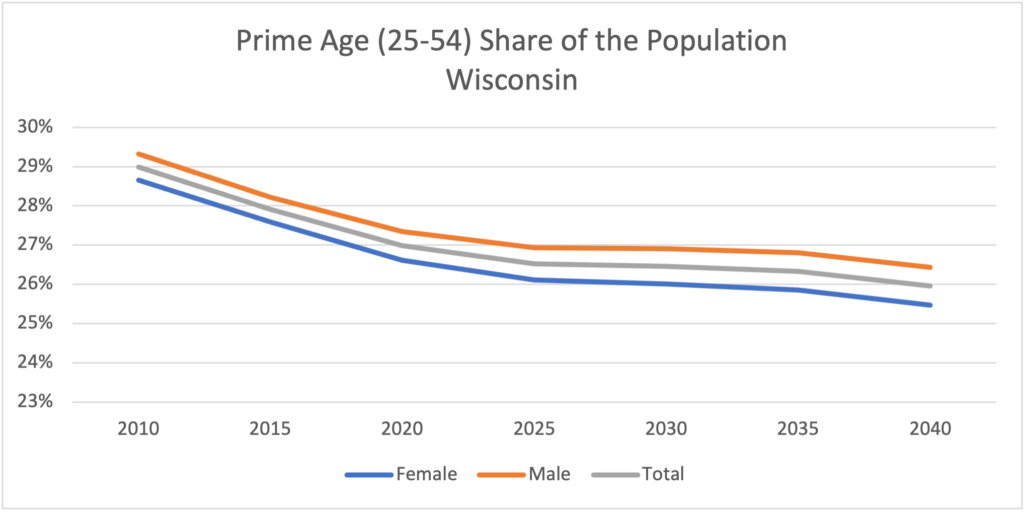
Source: Population and Household Projections, Wisconsin Department of Administration
Furthermore, fertility rates are falling, which means that natural population growth is unlikely to resolve the long run labor demand challenge. Note that the number of births in Wisconsin and the U.S. declined significantly from 1955 to 1975 and has remained low since then, exacerbating the shortage of workers we have today (Figure 3, authors’ analysis of Wisconsin Department of Health Services data. The baby boomer generation has made up a large share of the workforce over the past few decades and the incoming generational cohorts are too small to offset their retirement and support the growing labor demand (Elliott, 2023). The increase in people aging out of the workforce paired with a lower share of the prime age population will continue to put pressure on the future labor supply.
FIGURE 3: FERTILITY RATE
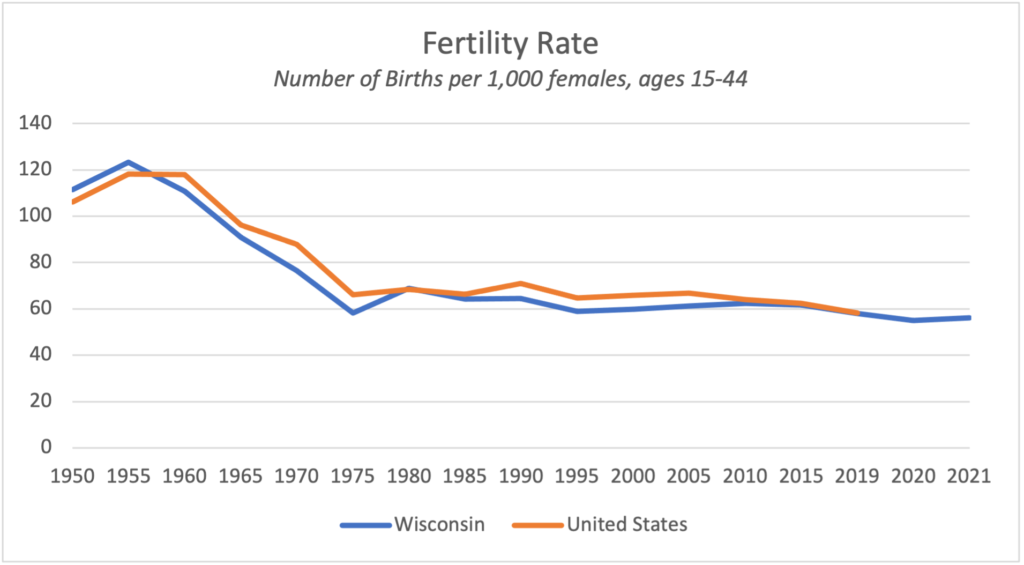
Source: WISH: Other Measures of Fertility, Wisconsin Department of Health Services
While increased migration, whether domestic or international, is one path to closing the workforce gap, it will not solve the problem alone as the number of job openings is large compared to the number of people moving to Wisconsin. An intractably large influx of international migrants would be needed to significantly alleviate the labor shortage – a level that is not feasible given current migration trends in Wisconsin. Between 2022 and 2023, approximately 13,653 international migrants moved to Wisconsin: just 1.20% of all international migrants coming to the U.S. in the same time period. Wisconsin is home to 1.8% of the U.S. population, so it is receiving fewer immigrants than is proportional to its share of the population (U.S. Census Bureau, 2023).
Wisconsin has also historically experienced low domestic in-migration, receiving only a net 5,648 people between 2022 and 2023. That leaves a total increase of approximately 19,000 people migrating to Wisconsin domestically and internationally. Assuming a range of ages and educational backgrounds of new residents, this is still far short of the average 227,000 jobs available per month in 2022. (authors’ analysis of U.S. Bureau of Labor Statistics data). Even if we consider fluctuation in annual migration and job openings in recent years due to the pandemic, the relative magnitude of openings to newcomers suggests other strategies are necessary to address the labor shortage.
Another pathway to addressing the labor crisis is to support people with barriers to employment. Women’s labor force participation remains lower than men’s, and childcare may be a key factor (Schochet & Malik, 2017; Parker, 2015; Conroy, Deller, & Kures, 2018). While important gains were made in women’s labor force participation for all ages (16-65) from 1950 through the 1980s, growth in women’s labor force participation stalled in the late 1990s and early 2000s (Figure 4) without reaching parity with men. In Wisconsin, men’s labor force participation rate (ages 20-64) is 84.6%, while women’s labor force participation rate (ages 20-64) sits at 79% (U.S. Census Bureau, 2022). In total, approximately 350,000 women (ages 20-64) in Wisconsin are not in the labor force, representing a large potential target audience for growing the labor force.
FIGURE 4: WOMEN’S LABOR FORCE PARTICIPATION AGES 16-65
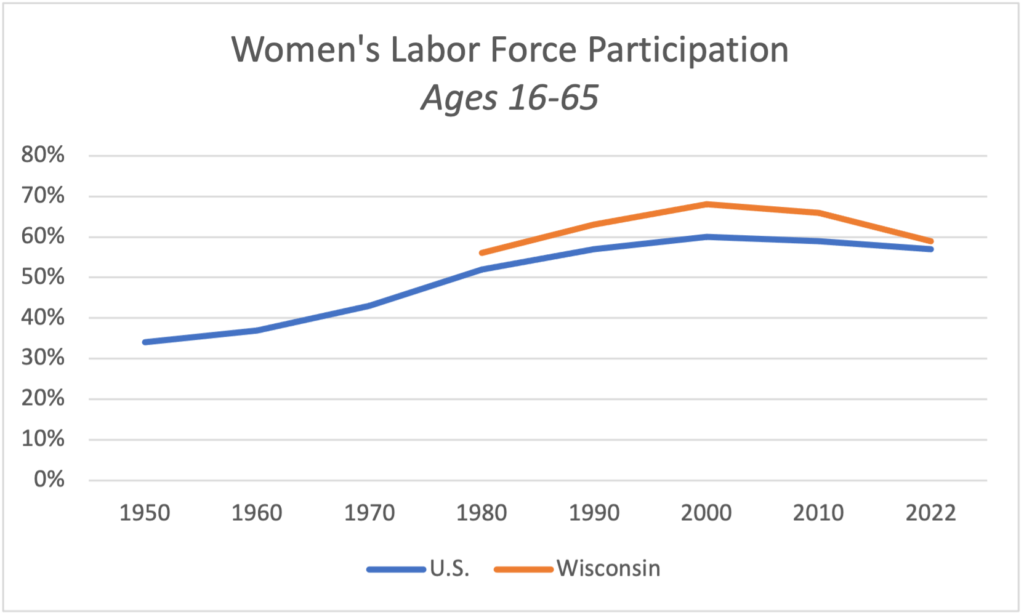
Source: TED: The Economics Daily, U.S. Bureau of Labor Statistics
If women’s labor force participation were at parity with men’s, there would be an additional 93,378 women in the labor force, which could partially offset the labor shortage. While many factors can affect labor force participation – such as education and skills, transportation availability, health limitations, among others. – childcare likely plays a key role for women in particular. Research from the Center for American Progress and the National Survey on Children’s Health shows that in 2016, nearly 2 million parents of children aged 5 and younger had to quit a job, not take a job, or greatly change their job because of problems with childcare (Schochet & Malik, 2017).
The Pew Research Center further found that mothers were more likely than fathers to report career interruptions due to family needs, and that they devote more time to childcare overall (Parker, 2015). Additionally, a previous WIndicator reported a correlation between prime age women’s labor force participation and children under the age of five, indicating that women’s labor force participation is inversely related to the number of children under five in Wisconsin (Conroy, Deller, & Kures, 2018). A September 2020 survey in the state found that 42% of women reported that they had cut back on hours or quit a job due to childcare costs, compared to 20% of men (Conroy & Runge, 2020).
While expanding childcare availability could help expand women’s labor force participation, affordability is also a challenge. There are substantial childcare cost burdens across nearly all parts of Wisconsin. The U.S. Department of Health and Human Services generally defines childcare to be affordable if families spend 7% or less of their income on it (2016). However, 2022 data shows that center-based infant childcare for one child costs more than 7% of median family income in every county of Wisconsin that has available data [2]. As shown in Figure 5, costs range from 8.0% of median family income (Oconto County) to 26% (Milwaukee County), and the state average is 16.4%; more than double the federally-defined affordability threshold (U.S. Department of Labor, 2022). Severe childcare cost burdens can change the calculation for families on whether one or both parents should work. In many cases, it is more cost effective for one parent to stay home, most often the mother.
FIGURE 5: CHILDCARE COSTS IN WISCONSIN, Center-based Infant Childcare Costs for One Child as a Percent of Median Family
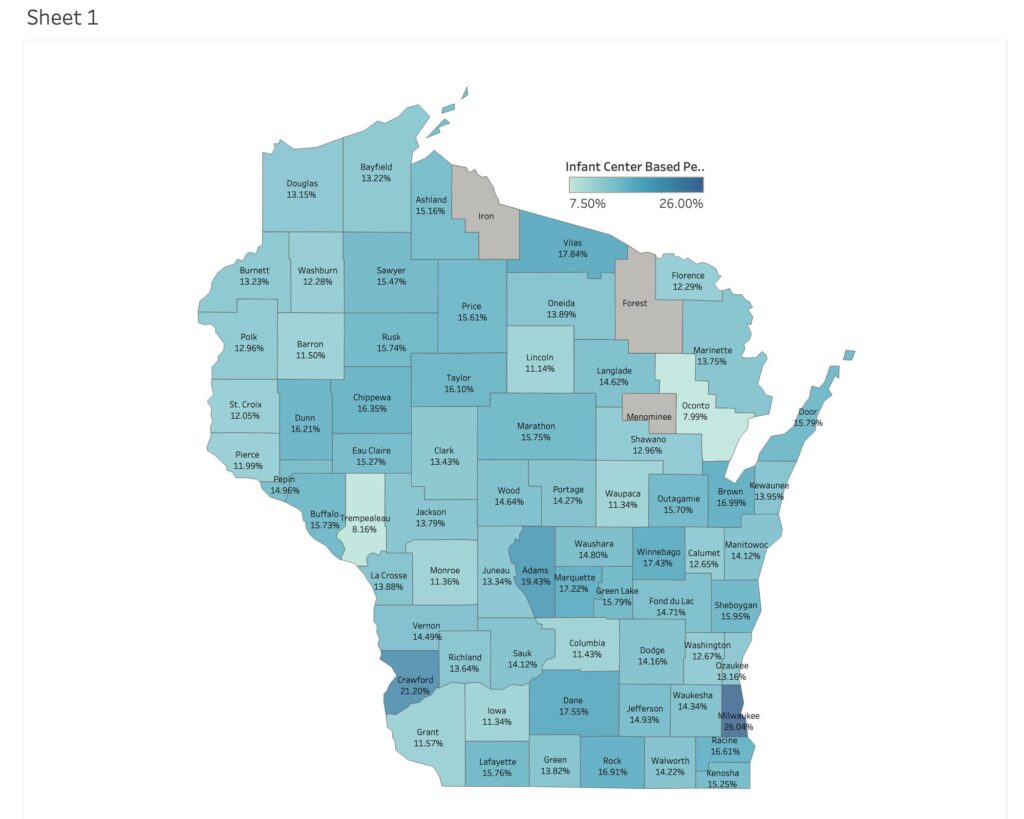
Source: National Database of Childcare Prices, U.S. Department of Labor (2022)
Quality childcare can contribute to social, emotional, and cognitive development and long-term economic and physical wellbeing. In broadening access to childcare, it is imperative that quality of care is not sacrificed for sake of lowering costs in order to realize the long-term economic and individual benefits. One study found that children who were placed into an intensive preschool intervention program received higher lifetime earnings and engaged in lower levels of criminal activity by age 40 than the control group (Nores, Belfield, Barnett, & Schweinhart, 2005). The treatment group attended a center-based program for 2.5 hours each weekday morning with higher- trained teachers and a lower student-to-teacher ratio than the control group. Families in the treatment group also participated in home visits from teachers and attended parent group meetings.
Nores et al. ultimately found that for every $1 invested, the program repaid $12.90 in individual and public benefits, including increased tax revenues, lower criminal justice expenditures, and lower welfare payments. Additional research has found that the more time children spend in high-quality care, the weaker the association between family income and childhood achievement, helping to level the playing field for low-income families (Dearing, McCartney, & Taylor, 2009). Quality childcare may also improve workers’ productivity as they are less likely distracted by worry about the safety of their children or limited by unreliable care. Childcare can also lead to higher earnings for women and alleviate the gender-wage gap, which has important economy-wide benefits (Conroy et al. 2024).
Many states have taken steps to make childcare more widely available and affordable, providing insight on potential strategies for Wisconsin. After federal COVID-relief dollars for childcare dried up, many states stepped in to dedicate additional funds to support providers. One of the key barriers to accessible childcare is a workforce shortage within the childcare industry itself, keeping costs high and preventing service expansion. Childcare is notoriously one of the lowest-paid industries in the country – consistently paying below a living wage in almost every state – and many workers report difficulties affording their own childcare (Mclean et al., 2021).
Kentucky sought to address this by making all childcare center employees eligible for the state’s Child Care Assistance Program (CCAP), which provides subsidies to families to pay for childcare. Expanding the program to all childcare employees, regardless of income, can help stabilize the industry’s workforce, and in turn expand the overall supply of childcare. Some states are further supporting the childcare workforce by supplementing wages. Maine’s Early Childhood Workforce Salary Supplement Program provides monthly stipends of $400 on average to increase childcare workers’ wages and help providers retain staff in a competitive labor market. Similarly, the Minnesota Great Start Compensation Support Payment Program provides monthly payments to childcare providers to help fund staff compensation and benefits. Programs that directly support childcare providers can help grow the capacity of the industry, which can ultimately allow more parents – particularly mothers – to participate in the labor force while providing quality education to young children.
In the absence of federal funds on this front, Wisconsin can explore similar programs to strengthen the state’s childcare infrastructure. Doing so can help more parents join the workforce and improve early childhood educational outcomes as well generate broader economic benefits. Accessible, quality childcare is a pathway for both supporting the labor needs of today and building a strong labor force in the future.
[1] Preliminary estimates for November 2023 put the number of job openings per unemployed person at 2.
[2] County level data for Iron, Forest, and Menominee counties is not available.
REFERENCES
Conroy, T., Wu, J. & Deller, S., (2024). Childcare Availability and Women’s Earnings in the U.S. Working paper.
Tschang, F.T., and Esteve A. (2021). Artificial intelligence as augmenting automation: Implications for employment. Academy of Management Perspectives 35.4 (2021): 642- 659. DOI:10.5465/amp.2019.0062
U.S. Bureau of Labor Statistics. (2023). Job Openings and Labor Turnover Survey.
U.S. Census Bureau. “Employment Status.” American Community Survey, ACS 1-Year Estimates Subject Tables, Table S2301, 2022.
U.S. Census Bureau, Population Division. (2022, December). Estimates of the Components of Resident Population Chane for the United States, Regions, States, District of Columbia, and Puerto Rico: April 2020 to July 1, 2022 (NST-EST2022-COMP).
U.S. Department of Labor. (2023). National Database of Childcare Prices.
Caroline Corona is a Graduate Research Assistant at the Division of Extension and a Master’s in Public Affairs Candidate at the La Follette School of Public Affairs at the University of Wisconsin-Madison.
Charles Zumbrunnen is an Undergraduate Research Assistant and Sophomore studying Economics and Mathematics at the University of Wisconsin-Madison.
Dr. Tessa Conroy is an Associate Professor in the Department of Applied and Agricultural Economics, College of Agricultural and Life Sciences, and an Economic Development Specialist with the Division of Extension at the University of Wisconsin-Madison. She can be reached at tessa.conroy@wisc.edu
FUNDING STATEMENT
This work was supported by a grant from the United States Department of Commerce Economic Development Administration in support of Economic Development Authority University Center (Award No. ED16CHl3030030 and ED21 CHl3030029). Any opinions, findings, conclusions or recommendations expressed in this material are those of the authors and do not necessarily reflect the views of the U.S. Department of Commerce Economic Development Administration.

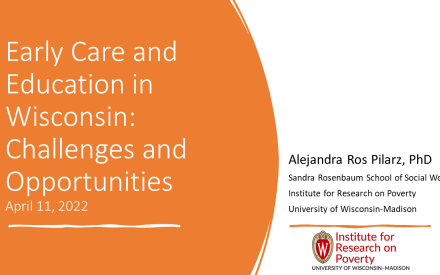 Early Care and Education in Wisconsin: Challenges and Opportunities
Early Care and Education in Wisconsin: Challenges and Opportunities WIndicators Volume 3, Number 5: Are the Kids Alright? Women, Work, & Childcare
WIndicators Volume 3, Number 5: Are the Kids Alright? Women, Work, & Childcare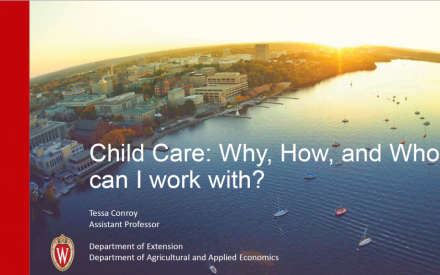 February 6, 2020 Lunch N Learn: Getting Access to Childcare: Why? How? and Who to Work With?
February 6, 2020 Lunch N Learn: Getting Access to Childcare: Why? How? and Who to Work With? WIndicators Volume 2, Number 2: Childcare as an Economic Development Strategy
WIndicators Volume 2, Number 2: Childcare as an Economic Development Strategy


